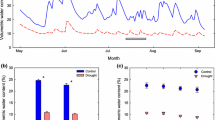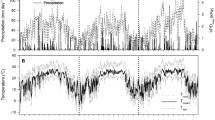Abstract
Soil moisture content and leaf area index (LAI) are properties that will be particularly important in mediating whole system responses to the combined effects of elevated atmospheric [CO2], warming and altered precipitation. Warming and drying will likely reduce soil moisture, and this effect may be exacerbated when these factors are combined. However, elevated [CO2] may increase soil moisture contents and when combined with warming and drying may partially compensate for their effects. The response of LAI to elevated [CO2] and warming will be closely tied to soil moisture status and may mitigate or exacerbate the effects of global change on soil moisture. Using open-top chambers (4-m diameter), the interactive effects of elevated [CO2], warming, and differential irrigation on soil moisture availability were examined in the OCCAM (Old-Field Community Climate and Atmospheric Manipulation) experiment at Oak Ridge National Laboratory in eastern Tennessee. Warming consistently reduced soil moisture contents and this effect was exacerbated by reduced irrigation. However, elevated [CO2] mitigated the effects of warming and drying on soil moisture. LAI was determined using an AccuPAR ceptometer and both the leaf area duration (LAD) and canopy size were increased by irrigation and elevated [CO2]. Changes in LAI were closely linked to soil moisture status. The climate of the southeastern United States is predicted to be warmer and drier in the future, and this research suggests that although elevated [CO2] will ameliorate the effects of warming and drying, losses of soil moisture will cause declines in the LAI of old field ecosystems in the future.




Similar content being viewed by others
References
Ainsworth EA, Rogers A (2007) The response of photosynthesis and stomatal conductance to rising [CO2]: mechanisms and environmental interactions. Plant Cell Environ 30:258–270
Blair E, Fleer Z (2002) Early growth stages of Lespedeza cuneata are a factor in its ability to colonize in tallgrass prairies. Tillers 3:11–14
Carter EB, Theodorou MK, Morris P (1997) Responses of Lotus corniculatus to environmental change, effects of elevated CO2, temperature and drought on growth and plant development. New Phytol 136:245–253
Caspersen JP, Pacala SW, Jenkins JC, Hurtt GC, Moorcroft PR, Birdsey RA (2000) Contributions of land-use history to carbon accumulation in US forests. Science 290:1148–1151
Chornesky EA, Bartuska AM, Aplet GH, Britton KO, Cummings-Carlson J, Davis FW, Eskow J, Gordon DR, Gottschalk KW, Haack RA, Hansen AJ, Mack RN, Rahel FJ, Shannon MA, Wainger LA, Wigley TB (2005) Science priorities for reducing the threat of invasive species to sustainable forestry. Bioscience 55:335–348
Cowling SA (1999) Simulated effects of low atmospheric CO2 on structure and composition of North American vegetation at the Last Glacial Maximum. Global Ecol Biogeogr 8:81–93
Cowling SA, Field CB (2003) Environmental control of leaf area production: implications for vegetation and land-surface modeling. Glob Biogeochem Cycles 17:1–14
Dermody O (2006) Mucking through multifactor experiments; design and analysis of multifactor studies in global change research. New Phytol 172:598–600
Dermody O, Long SP, DeLucia EH (2006) How does elevated CO2 or ozone affect the leaf-area index of soybean when applied independently? New Phytol 169:145–155
Diffenbaugh NS (2005) Atmosphere-land cover feedbacks alter the response of surface temperature to CO2 forcing in the western United States. Clim Dyn 24:237–251
DiTomaso JM, Kyser GB, Pirosko CB (2003) Effect of light and density on yellow starthistle (Centaurea solstitialis) root growth and soil moisture use. Weed Sci 51:334–341
Drake BG, Gonzalez Meler MA, Long SP (1997) More efficient plants: a consequence of rising atmospheric CO2. Annu Rev Plant Physiol 48:609–639
Ehrenfeld J (2003) Effects of exotic plant invasions on soil nutrient cycling processes. Ecosystems 6:503–523
Emmett BA, Beier C, Estiarte M, Tietema A, Kristensen HL, Williams D, Penuelas J, Schmidt I, Sowerby A (2004) The response of soil processes to climate change: results from manipulation studies of shrublands across an environmental gradient. Ecosystems 7:625–637
English NB, Weltzin JF, Fravolini A, Thomas L, Williams DG (2005) The influence of soil texture and vegetation on soil moisture under rainout shelters in a semi-desert grassland. J Arid Environ 63:324–343
Ewert F (2004) Modelling plant responses to elevated CO2: how important is leaf area index? Ann Bot 93:619–627
Ferris R, Sabatti M, Miglietta F, Mills RF, Taylor G (2001) Leaf area is stimulated in Populus by free air CO2 enrichment (POPFACE), through increased cell expansion and production. Plant Cell Environ 24:305–315
Filella I, Penuelas J, Llorens L, Estiarte M (2004) Reflectance assessment of seasonal and annual changes in biomass and CO2 uptake of a Mediterranean shrubland submitted to experimental warming and drought. Remote Sens Environ 90:308–318
Fuhrer J (2003) Agroecosystem responses to combinations of elevated CO2, ozone and global climate change. Agric Ecosyst Environ 97:1–20
Gamon JA, Field CB, Goulden ML, Griffin KL, Hartley AE, Joel G, Penuelas J, Valentini R (1995) Relationships between NDVI, canopy structure, and photosynthesis in three Californian vegetation types. Ecol Appl 5:28–41
Hanson PJ, Wullschleger SD, Norby RJ, Tschaplinski TJ, Gunderson CA (2005) Importance of changing CO2, temperature, precipitation, and ozone on carbon and water cycles of an upland-oak forest: incorporating experimental results into model simulations. Global Change Biol 11:1402–1423
Harper CW, Blair JM, Fay PA, Knapp AK, Carlisle JD (2005) Increased rainfall variability and reduced rainfall amount decreases soil CO2 flux in a grassland ecosystem. Global Change Biol 11:322–334
Hirose T, Ackerly DD, Traw MB, Bazzaz FA (1996) Effects of CO2 elevation on canopy development in the stands of two co-occurring annuals. Oecologia 108:215–223
Hsieh CI, Kiely G, Birkby A, Katul G (2005) Photosynthetic responses of a humid grassland ecosystem to future climate perturbations. Adv Water Resour 28:910–916
Kammann C, Grunhage L, Gruters U, Janze S, Jager HJ (2005) Response of aboveground grassland biomass and soil moisture to moderate long-term CO2 enrichment. Basic Appl Ecol 6:351–365
Long SP, Drake BG (1991) Effect of the long-term elevation of CO2 concentration in the field on the quantum yield of photosynthesis of the C3 sedge, Scirpus olneyi. Plant Physiol 96:221–226
Mohseni O, Stefan HG (2001) Water budgets of two watersheds in different climatic zones under projected climate warming. Clim Change 4:77–104
Murthy R, Barron-Gafford G, Dougherty PM, Engel VC, Grieve K, Handley L, Klimas C, Potosnak MJ, Zarnoch SJ, Zhang JW (2005) Increased leaf area dominates carbon flux response to elevated CO2 in stands of Populus deltoides (Bartr.). Global Change Biol 11:716–731
Norby RJ, Luo YQ (2004) Evaluating ecosystem responses to rising atmospheric CO2 and global warming in a multi-factor world. New Phytol 162:281–293
Norby RJ, Edwards NT, Riggs JS, Abner CH, Wullschleger SD, Gunderson CA (1997) Temperature-controlled open-top chambers for global change research. Global Change Biol 3:259–267
Nowak RS, Ellsworth DS, Smith SD (2004) Functional responses of plants to elevated atmospheric CO2 – do photosynthetic and productivity data from FACE experiments support early predictions? New Phytol 162:253–280
Obrist D, Verburg PSJ, Young MH, Coleman JS, Schorran DE, Arnone JA (2003) Quantifying the effects of phenology on ecosystem evapotranspiration in planted grassland mesocosms using EcoCELL technology. Agric For Meteorol 118:173–183
Pearcy RW (1983) The light environment and growth of C3 and C4 tree species in the understory of a Hawaiian forest. Oecologia 58:19–25
Phillips DL, Johnson MG, Tingey DT, Catricala CE, Hoyman TL, Nowak RS (2006) Effects of elevated CO2 on fine root dynamics in a Mojave Desert community: a FACE study. Glob Chang Biol 12:61–73
Prather M, Ehhalt D, Dentener F, Derwent R, Dlugokencky E, Holland E, Isaksen I, Katima J, Kirchhoff V, Matson P, Midgley P, Wang M (2001) Atmospheric chemistry and greenhouse gases. In: Houghton YDJT, Griggs DJ, Noguer M, van der Linder PJ, Dai X, Maskell K, Johnson CA (eds) Climate change 2001: the scientific basis. Contribution of Working Group I to the Third Assessment Report of the Intergovernmental Panel on Climate Change. Cambridge University Press, Cambridge, pp 183–240
Richter GM, Semenov MA (2005) Modelling impacts of climate change on wheat yields in England and Wales – assessing drought risks. Agric Syst 84:77–97
Rowell DP, Jones RG (2006) Causes and uncertainty of future summer drying over Europe. Clim Dyn 27:281–299
Savabi MR, Stockle CO (2001) Modeling the possible impact of increased CO2 and temperature on soil water balance, crop yield and soil erosion. Environ Model Software 16:631–640
Schimel DS, House JI, Hibbard KA, Bousquet P, Ciais P, Peylin P, Braswell BH, Apps MJ, Baker D, Bondeau A, Canadell J, Churkina G, Cramer W, Denning AS, Field CB, Friedlingstein P, Goodale C, Heimann M, Houghton RA, Melillo JM, Moore B, Murdiyarso D, Noble I, Pacala SW, Prentice IC, Raupach MR, Rayner PJ, Scholes RJ, Steffen WL, Wirth C (2001) Recent patterns and mechanisms of carbon exchange by terrestrial ecosystems. Nature 414:169–172
Seneviratne SI, Pal JS, Eltahir EAB, Schar C (2002) Summer dryness in a warmer climate: a process study with a regional climate model. Clim Dyn 20:69–85
Shaw MR, Zavaleta ES, Chiariello NR, Cleland EE, Mooney HA, Field CB (2002) Grassland responses to global environmental changes suppressed by elevated CO2. Science 298:1987–1990
Smith SD, Huxman TE, Zitzer SF, Charlet TN, Housman DC, Coleman JS, Fenstermaker LK, Seemann JR, Nowak RS (2000) Elevated CO2 increases productivity and invasive species success in an arid ecosystem. Nature 408:79–82
Strayer DL, Eviner VT, Jeschke JM, Pace ML (2006) Understanding the long-term effects of species invasions. Trends Ecol Evol 21:645–651
Tschaplinski TJ, Stewart DB, Hanson PJ, Norby RJ (1995) Interactions between drought and elevated CO2 on growth and gas-exchange of seedlings of 3 deciduous tree species. New Phytol 129:63–71
Wan S, Luo Y, Wallace LL (2002) Changes in microclimate induced by experimental warming and clipping in tallgrass prairie. Global Change Biol 8:754–768
Wand SJE, Midgley GF, Jones MH, Curtis PS (1999) Responses of wild C4 and C3 grass (Poaceae) species to elevated atmospheric CO2 concentration: a meta-analytic test of current theories and perceptions. Global Change Biol 5:723–741
Zavaleta ES, Thomas BD, Chiariello NR, Asner GP, Shaw MR, Field CB (2003) Plants reverse warming effect on ecosystem water balance. Proc Natl Acad Sci U S A 100:9892–9893
Zeng N, Qian HF, Roedenbeck C, Heimann M (2005) Impact of 1998–2002 midlatitude drought and warming on terrestrial ecosystem and the global carbon cycle. Geophys Res Lett 32
Acknowledgements
The authors wish to thank Onike Mnvaza, Elizabeth Ferguson and Zachary Kirschenmann for valuable help with data collection. We would also like to thank Aimee Classen, Colleen Iversen, Hector Castro and David Westin for comments on an earlier draft of this manuscript. The research was sponsored by US Department of Energy’s Office of Science, Biological and Environmental Research Program through Grant No. DE-FG02-02ER63366 to the University of Tennessee and conducted at Oak Ridge National Laboratory, which is managed by UT Battelle, LLC, for the US Department of Energy under Contract DE-AC05-00OR22725.
Author information
Authors and Affiliations
Corresponding author
Additional information
Responsible Editor: Yan Li.
Rights and permissions
About this article
Cite this article
Dermody, O., Weltzin, J.F., Engel, E.C. et al. How do elevated [CO2], warming, and reduced precipitation interact to affect soil moisture and LAI in an old field ecosystem?. Plant Soil 301, 255–266 (2007). https://doi.org/10.1007/s11104-007-9443-x
Received:
Accepted:
Published:
Issue Date:
DOI: https://doi.org/10.1007/s11104-007-9443-x




